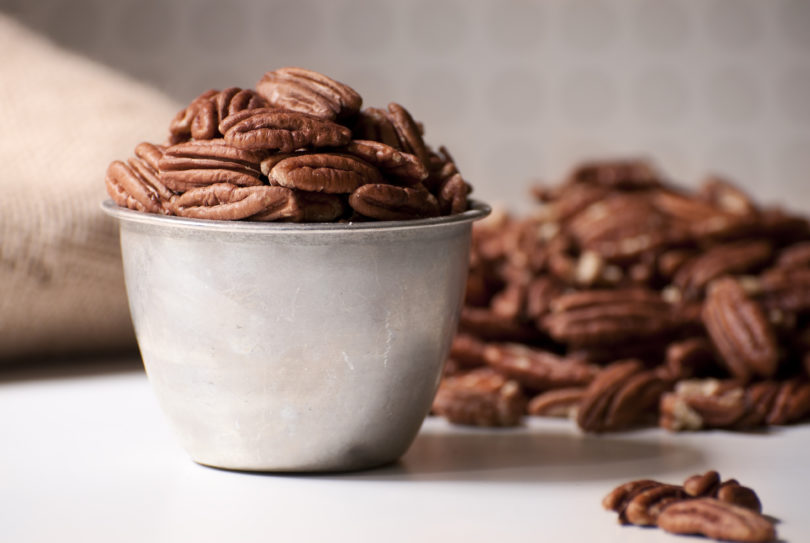Patients frequently ask me which nut is the best. I give the same answer when asked which is the best fruit or the best vegetable. All of them. All nuts – like all fruits and vegetables – have health benefits, and every one of them can be part of your balanced diet. Each fruit, vegetable, and nut has a unique array of vitamins, minerals and phytochemicals. The word phytochemical literally means plant chemical, and today, scientists have identified thousands of them. They provide the plant with color, aroma and flavor. In the diet, these edible health-boosters work with other phytochemicals and nutrients to fend off chronic diseases like cancer and heart disease.
Harvard researchers reported that women who ate at least five servings of tree nuts or peanuts weekly were nearly 30 percent less likely to have type 2 diabetes than women who rarely or never ate nuts. Peanut butter was also associated with a lower risk of the disease.
Other studies have found that people who eat tree nuts weigh less; have smaller waists; consume more fiber, vitamin E, calcium, magnesium and potassium; have lower intakes of sodium; and boast lower levels of C-reactive protein, a marker of inflammation compared to people who don’t eat nuts.
When researchers pooled data from several intervention studies, they found that individuals who included nuts in their diets experienced an average of 5.1% reduction in total cholesterol and 7.4% decrease in LDL (bad) cholesterol. Individuals with high triglycerides had a 10.2% decline in serum triglyceride levels. Different types of nuts had similar effects, but the effects were dose-related, meaning that the more nuts consumed the greater the improvements.
All nuts have a hefty amount of fat, but little is the unhealthy saturated kind. Since they pack 160 to 200 calories per one-ounce serving, stick to about an ounce per day. Unless you’re very slim, don’t add nuts to your diet without giving up calories elsewhere.
Walnuts
- The walnut is the only nut with appreciable ALA, an omega-3 fatty acid with heart health benefits.
- Coat fish or poultry with chopped walnuts and herbs.
- Toss walnuts into side dishes such as rice, quinoa and barley.
- Stir some into your oatmeal or cottage cheese or sprinkle over your favorite cold cereal.
Almonds
- Just 1-ounce – 23 almonds -per day gives you a third of your daily dose of vitamin E.
- Grind almonds in a food processor to make “nut crumbs.” Sprinkle them over casseroles like you would bread crumbs. Grind them more to make a flour to use in baked goods or to coat poultry and fish.
- Spread almond butter over your toast instead of peanut butter.
- Add coarsely chopped almonds to your favorite roast chicken or turkey stuffing.
Pistachios
- The pistachio is dubbed the skinny nut because each one has only three calories. The shells aid dieters in two more ways: they prolong the eating time, and they serve as a visual cue encouraging mindful eating.
- Pistachios contain lutein and zeaxanthin, two relatives of beta-carotene that are important to the health of the eye and the brain.
- The best in-shell pistachios will make a crisp, deep crackle and not a deep thud when shaken in the hand.
- Stir chopped pistachios into chicken salad.
- Toss together pistachios, dried fruit and a few chocolate chips for a delicious, nutrient-packed trail mix.
Brazil nuts
- Just one Brazil nut has a day’s supply of the antioxidant mineral selenium.
- Make a trail mix by mixing Brazil nuts with other nuts and dried fruit.
- Add some chopped Brazil nuts to pasta dishes.
Hazelnuts
- Choose shelled nuts with tight skins. Store them in the refrigerator or freezer for up to four months. Store roasted hazelnuts for up to two years.
- Grind hazelnuts in a food processor and mix with fresh herbs and olive oil for a hazelnut pesto.
- Add a sophisticated touch to cookies with chopped hazelnuts.
Pecans
- Store shelled pecan in the refrigerator for up to nine months and in the freezer for as long as two years.
- Sprinkle toasted, chopped pecans on green salads and fruit salads.
- Mix chopped pecans into your pancake batter.
- Just before serving, toss toasted pecans into a couscous or quinoa pilaf.
Peanuts
- Though technically a legume, peanuts are more nutritionally similar to tree nuts.
- Like pistachio shells, peanut shells can keep you from eating too quickly.
- Look for peanut butter made with only peanuts and salt or make your own in a food processor.
- Sprinkle chopped peanuts over a stir fry.

